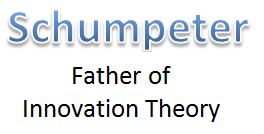You’d be forgiven for believing that Christensen’s 1997 classic The Innovator’s Dilemma was the first to detail the phenomenon in all its applecart-overturning glory: in fact it was explored in 1939. Watch this incisive lecture.
“A railroad through new country… upsets all conditions of location, all cost calculations, all production functions within its radius of influence; and hardly any “ways of doing things” which have been optimal before remain so afterward” Joseph Schumpeter, Business Cycles
http://www.youtube.com/watch?v=oeCpDIiR150
Here’s an extract I put together from the Wikipedia article on Schumpeter:
Joseph Alois Schumpeter (8 February 1883 – 8 January 1950) was an Austrian-American economist and political scientist. He popularized the term “creative destruction” in economics
A recent huge and highly regarded Schumpeter biography: Prophet of Innovation: Joseph Schumpeter and Creative Destruction by Harvard’s Thomas McCraw (2007)
Innovation
Schumpeter identified innovation as the critical dimension of economic change. He argued that economic change revolves around innovation, entrepreneurial activities and market power and sought to prove that innovation-originated market power could provide better results than the invisible hand & price competition.
He argues that technological innovation often creates temporary monopolies, allowing abnormal profits that would soon be competed away by rivals and imitators.
He said that these temporary monopolies were necessary to provide the incentive necessary for firms to develop new products and processes
His legacy
For some time after his death, Schumpeter’s views were most influential among various heterodox economists, especially European, who were interested in industrial organization, evolutionary theory, and economic development, and who tended to be on the other end of the political spectrum from Schumpeter and were also often influenced by Keynes, Karl Marx, and Thorstein Veblen.
Robert Heilbroner was one of Schumpeter’s most renowned pupils, who wrote extensively about him in The Worldly Philosophers.
Other outstanding students of Schumpeter’s include the economists Nicholas Georgescu-Roegen and Hyman Minsky and former chairman of the Federal Reserve, Alan Greenspan.
Robert Solow, Nobel Prize in Economics, was his student at Harvard, and he expanded on Schumpeter’s theory.
Today, Schumpeter has a following outside of standard textbook economics, in areas such as in economic policy, management studies, industrial policy, and the study of innovation.
Schumpeter was probably the first scholar to develop theories about entrepreneurship.
For instance, the European Union’s innovation program, and its main development plan, the Lisbon Strategy, are influenced by Schumpeter.
The International Joseph A. Schumpeter Society awards the Schumpeter Prize.
The Schumpeter School of Business and Economics opened in October 2008 at the University of Wuppertal.
According to University President Professor Lambert T. Koch, “Schumpeter will not only be the name of the Faculty of Management and Economics, but this is also a research and teaching programme related to Joseph A. Schumpeter.”
On 17 September 2009, The Economist inaugurated a column on business and management named “Schumpeter.”
The publication has a history of naming columns after significant figures or symbols in the covered field, including naming its British affairs column after former editor Walter Bagehot and its European affairs column after Charlemagne.
The initial Schumpeter column praised him as a “champion of innovation and entrepreneurship” whose writing showed an understanding of the benefits and dangers of business that proved far ahead of its time.

